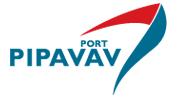Prabhudas Liladhar and First Choice advice to Subscribe to Gujarat Pipavav IPO:
The key highlights of their research report are as follows for subscribing:----
1)APM Terminals, one of the world’s largest terminal operators with a global network of 50 terminals in 34 countries, acquired 13.5% equity in the company in 2001. In 2005 APM terminals acquired management control by purchasing shares from SKIL group. Currently APM Terminals own 57.9% of the company’s stake.In the year ended December 31, 2009, APM Terminals handled 31.0 million TEUs and had revenues of more than US$3.00 billion. APM Terminals is part of APMM Group, which had revenues of US$48.5 billion for the year ended December 31, 2009. Owing to its relationship with APM Terminals company gets access to modern technology, operational knowhow,best industry practices, increased bargaining power and competitive rates for purchase of port equipment, and access to experienced personnel resources from APM Terminals. This is likely to benefit the company in the long term.In addition to this shipping major “Maersk Line” is also a group company, which has fleet of more than 500 vessels and presence across the globe, being a group company it would help the company to have business as the Maersk line may prefer its group company’s port.
2) APM Terminals Pipavav was India’s first private sector port,and is one of the principal gateways on the west coast of India.
3)The majority of bulk cargo business comes from international trade. In terms of volume, the business has grown at CAGR of 42.5% from 2007 to 2009.
4)Proceeds of the issue will be used for:
• GPPL will use Rs. 300.0 Crs towards repayment of loan.
• Rs.82.5 Crs will be spent for investment in capital expenditure to improve and
enhance the infrastructure facilities at APM Terminals Pipavav
• Rs. 31.1 Crs investments in capital equipment which is needed on a recurring
basis to augment its cargo handling capacity
4)According to the CRISIL, total container capacity in India in fiscal 2010 was around 11.7 million TEUs, out of which 74% (i.e. 8.6 million TEUs) was in Maharashtra and Gujarat. In terms of throughput, CRISIL expects non-Major
Ports container throughput in India to grow at a CAGR of 27.0% in the next five years. Moreover, CRISIL expects dry bulk handling capacity in Gujarat and Maharashtra to grow at a CAGR of 15% over the next five years, from 71 million
tons in fiscal 2010 to 167 million tons in fiscal 2015. This will provide GPPL with tremendous growth opportunities.
5)Improving margins to make company profitable sooner than later. Over last few years company has been reporting losses at PAT level reflecting lower EBITDA margin and higher debt burden. However, with improved demand scenario and better pricing EBITDA margins has displayed a sharp improvement in 2009 and Q1 FY10. Company’s EBITDA margin has increased from 7.6% in 2008 to 20.1% in 2009 and further to 29.6% in Q1 FY10. With strong rebound in demand and higher utilization rates we expect the margins to improve further in coming quarters.
6) Post IPO, the gearing or Debt/ Equity of the company is expected to significantly reduce from 4.7x in September 2009 to 0.9x in CY12 as a major portion of the IPO proceeds will be used to pay off the loan under the loan
agreement. The reduction in interest costs will help improve the PAT margins significantly.
7)Port is strategically located near the entrance of the Gulf of Khambhat on the main maritime trade routes, which helps the company to serve imports from and exports to the Middle East, Asia, Africa and other international destinations. APM Terminals Pipavav provides significant logistic and cost advantages to shipping lines that service both the Mumbai area and the developing northern and north western regions of India. Due to its proximity to Mumbai, shipping lines have the flexibility to make an additional call to Pipavav and cater to cargo coming from the north western belt.Further, the existing road and rail network from APM Terminals Pipavav to inland regions of northern and northwestern India, including Delhi, and the available land for future transportation initiatives provides the company with a competitive advantage for attracting larger volumes of cargo.
8)GPPL has the right to develop approximately 1,561 acres of land at APM Terminals Pipavav of which it has developed approximately 485 acres. While the remaining undeveloped land can be used for further expansion of port operations, including for additional berthing and cargo handling facilities both at the waterfront and in the back-up areas. The Port has extensive shore-based area to allow development of backup infrastructure and allied industries. This available land will help GPPL to expand the market for its port services and provide sufficient resources for future expansion.
Looking at the long term growth prospects of the company and scope to expand the margin we recommend to SUBSCRIBE to this IPO.
 Zerodha (Trading Account)
Zerodha (Trading Account)
 Zerodha (Trading Account)
Zerodha (Trading Account)



